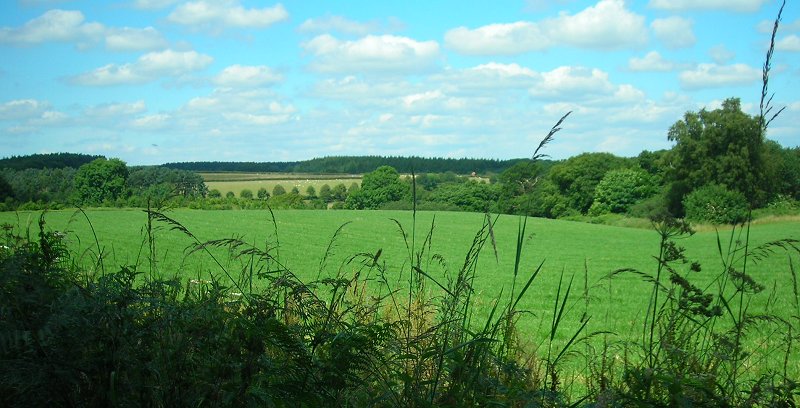
Back to the Index page
[Species lists below] 5 members attended this rather specialised meeting on a fine, sunny day, starting near the City of Troy maze on the Dalby road. Gill explained the rationale behind recording, and showed an old-fashioned recording card which had the plant names not only in Latin but also abbreviated. We all agreed that a very special, dedicated recorder was needed to use this! She then showed the modern equivalent – an A4 recording sheet, in either Latin or English formats, and offered people the chance to fill one in on the day (she also admitted that she didn’t in fact use such a sheet, preferring to enter records into a hand-held computer – and failing that writing the names on a blank sheet to be uploaded to the computer later).

We then started our walk which took in a variety of habitats: arable cropland, hedge-banks, Mugdale wood, and a rather overgrown footpath near Potter Hill Farm. One of the highlights was finding bugloss Anchusa arvensis – one of those arable weeds that is much less common than it used to be. Partly because of the different habitats we recorded over 170 different species – not bad for one afternoon in an area only a mile or so across.
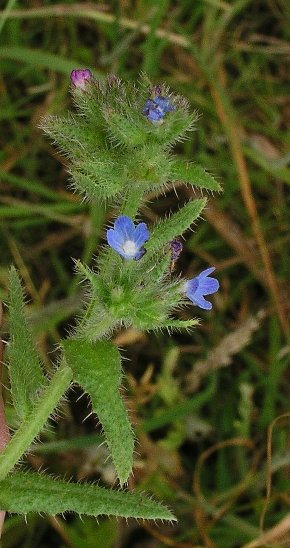
Bugloss (Anchusa arvensis)
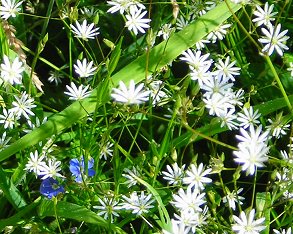 In the wood we noted plenty of lesser stitchwort, the starry flowers living up to the Latin name of Stellaria. It was disappointing to see quite a bit of Himalayan balsam near the beck, but good that someone had clearly been cutting it in an attempt to control it, though I fear if it is allowed to seed the problem will get worse in future years.
In the wood we noted plenty of lesser stitchwort, the starry flowers living up to the Latin name of Stellaria. It was disappointing to see quite a bit of Himalayan balsam near the beck, but good that someone had clearly been cutting it in an attempt to control it, though I fear if it is allowed to seed the problem will get worse in future years.
In the wood we saw a fallen trunk with what I think were oyster mushrooms growing on it (see below). The only other fungi I saw were some giant hoof fungi on a dead but still upright birch trunk, that also had many woodpecker holes in it.

Oyster mushroom (Pleurotus ostreatus) on a dead log
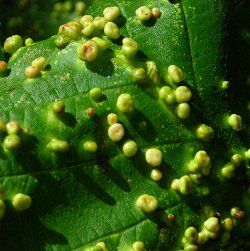
I also noticed a patch of gooseberry that had been completely stripped of leaves (leaving behind a rather nasty black deposit and the berries remaining on the bare twigs):
this was probably caused by sawfly larvae. Nematus olfaciens, Nematus leucotrochuss, Nematus ribesii and Pristiphora appendiculata are all known to feed on gooseberry, but without specimens it is impossible to be sure, and we can’t exclude a polyphage, i.e. a species that feeds on several different plants. We also saw these little galls on alder (left), caused by the mite Eriophyes laevis (thanks to Carl Farmer and Stuart Dunlop for these ids).
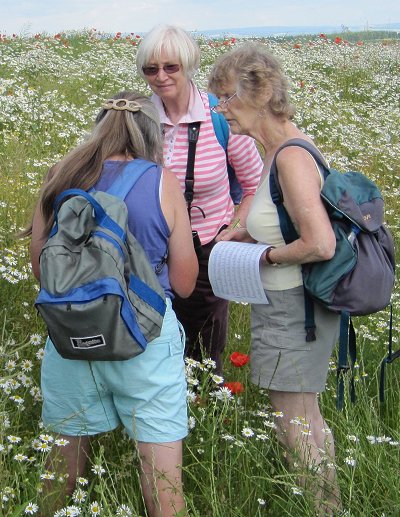 We went slowly and in true botanical fashion kept stopping to look carefully at the plants we found. It was very helpful to find many closely related plants growing together so we could compare them, for example pineappleweed, scented and scentless mayweeds – see the spread of (mostly) scented mayweed (and poppies) left – and all three small-flowered cranesbills (dovesfoot, cut-leaved and small-flowered).
We went slowly and in true botanical fashion kept stopping to look carefully at the plants we found. It was very helpful to find many closely related plants growing together so we could compare them, for example pineappleweed, scented and scentless mayweeds – see the spread of (mostly) scented mayweed (and poppies) left – and all three small-flowered cranesbills (dovesfoot, cut-leaved and small-flowered).
However, we also had time to spot some birds and butterflies. There were ringlets everywhere and also plenty of meadow browns, plus a few individuals of other species. It was a special thrill to see the comma, which looked freshly emerged with very bright colours, and also the red admiral of which we only got a fleeting glimpse.
Birds
Robin,
willow warbler,
skylark,
yellow hammer,
wood pigeon,
peewit,
chaffinch,
blackbird,
pheasant,
black cap,
garden warbler,
jay,
carrion crow,
curlew,
song thrush.
[Thanks to Janet Denney for this list]
Butterflies
Ringlet,
large white,
tortoiseshell,
small white,
meadow brown,
painted lady,
red admiral,
orange tip,
speckled wood,
comma.
...
and last, but not least, we heard a grasshopper.
[Again thanks to Janet for the list]
| Acer pseudoplatanus | Sycamore |
| Achillea millefolium | Yarrow |
| Aegopodium podagraria | Ground elder |
| Agrimonia eupatoria | Common agrimony |
| Agrostis gigantea | Black bent |
| Agrostis stolonifera | White or creeping bent |
| Agrostis capillaris | Fine or common bent [probably seen] |
| Alliaria petiolata | Hedge garlic |
| Allium ursinum | Ramsons |
| Alnus glutinosa | Alder |
| Alopecurus pratensis | Meadow foxtail |
| Anchusa arvensis | Bugloss |
| Angelica sylvestris | Angelica |
| Anisantha sterilis (Bromus sterilis) | Barren brome |
| Anthoxanthum odoratum | Sweet vernal grass |
| Anthriscus sylvestris | Cow parsley |
| Aphanes arvensis | Parsley piert |
| Arctium minus | Burdock |
| Arenaria serpyllifolia | Thyme-leaved sandwort |
| Arrhenatherum elatius | False oat |
| Arum maculatum | Cuckoo pint |
| Avena fatua | Wild oat |
| Bellis perennis | Daisy |
| Betula pendula | Silver birch |
| Brachypodium sylvaticum | Slender false brome |
| Bromus ramosus (Bromopsis ramosa) | Hairy brome |
| Calystegia sepium | Hedge bindweed |
| Calystegia sylvatica | Large bindweed |
| Capsella bursa-pastoris | Shepherd’s purse |
| Cardamine flexuosa | Wavy bittercress |
| Cardamine pratensis | Milkmaid, cuckoo-flower or lady’s smock |
| Castanea sativa | Sweet chestnut |
| Centaurea nigra | Common knapweed (incl. rayed form) |
| Cerastium fontanum | Mouse ear, common |
| Cerastium glomeratum | Mouse ear, sticky |
| Chaerophyllum temulem | Rough chervil |
| Chrysosplenium oppositifolium | Opposite-leaved golden saxifrage |
| Circaea lutetiana | Enchanter’s nightshade |
| Cirsium arvense | Thistle, creeping |
| Cirsium vulgare | Thistle, spear |
| Conopodium majus | Pignut |
| Corylus avellana | Hazel |
| Crataegus monogyna | Hawthorn |
| Cruciata laevipes | Crosswort |
| Dactylis glomerata | Cocksfoot |
| Dactylorhiza fuchsii | Common spotted orchid |
| Deschampsia caespitosa | Tufted hair grass |
| Digitalis purpurea | Foxglove |
| Dryopteris affinis | Golden-scaled male fern (probably!) |
| Dryopteris dilatata | Common buckler fern |
| Dryopteris filix-mas | Male fern |
| Elymus caninus = Agropyron | Bearded couch |
| Elymus repens (Elytrigia) | Couch |
| Epilobium ciliatum | American willowherb |
| Epilobium hirsutum | Great willowherb (?garden throwout**) |
| Epilobium montanum | Broad-leaved willowherb |
| Epilobium obscurum | Short-fruited willowherb |
| Epilobium tetragonum | Square-stalked willowherb |
| Equisetum arvense | Field horsetail |
| Fagus sylvatica | Beech |
| Festuca gigantea | Giant fescue |
| Festuca rubra | Red fescue |
| Filipendula ulmaria | Meadowsweet |
| Fraxinus excelsior | Ash |
| Galeopsis tetrahit | Common hemp nettle |
| Galium aparine | Cleavers |
| Galium odoratum | Woodruff |
| Galium verum | Lady’s bedstraw |
| Geranium dissectum | Cut-leaved cranesbill |
| Geranium molle | Dovesfoot cranesbill |
| Geranium pratense | Meadow cranesbill |
| Geranium pusillum | Small-flowered cranesbill |
| Geranium robertianum | Herb Robert |
| Glechoma hederacea | Ground ivy |
| Hedera helix | Ivy |
| Helictotrichon pubescens (Avenula pubescens) | Downy oat |
| Heracleum sphondylium | Hogweed |
| Holcus lanatus | Yorkshire Fog |
| Holcus mollis | Creeping Soft Grass |
| Hyacinthoides non-scripta | Bluebell |
| Ilex aquifolium | Holly |
| Impatiens glandulifera | Himalayan balsam |
| Juncus bufonius | Toad rush |
| Juncus effusus | Soft rush |
| Lactuca virosa | Great lettuce [?] |
| Lamium purpureum | Red dead nettle |
| Lapsana communis | Nipplewort |
| Larix sp. | Larch |
| Lathyrus pratensis | Meadow vetchling |
| Leontodon hispidus | Rough hawkbit |
| Lolium perenne | Rye Grass, Perennial |
| Lonicera periclymenum | Honeysuckle |
| Lotus corniculatus | Common birdsfoot trefoil |
| Lotus pedunculatus | Greater birdsfoot trefoil |
| Lysimachia nemorum | Yellow pimpernel |
| Malus sylvestris | Crab apple |
| Matricaria discoidea | Pineapple weed |
| Matricaria recutita | Mayweed, scented |
| Mentha sp. | Mint (garden throwout** - rotundifolia or hybrid) |
| Mercurialis perennis | Dog’s mercury |
| Moehringia trinerva | Three-nerved sandwort |
| Myosotis arvensis | Forgetmenot, field |
| Odontites verna | Red bartsia |
| Oxalis acetosella | Wood sorrel |
| Papaver dubium | Poppy, long headed |
| Papaver rhoeas | Poppy, common |
| Persicaria hydropiper | Water pepper |
| Persicaria maculosa | Redshank |
| Phleum pratense | Timothy |
| Pinus sylvestris | Scots pine |
| Plantago lanceolata | Plantain, ribwort |
| Plantago major | Plantain, greater |
| Poa annua | Meadow Grass, Annual |
| Poa trivialis | Meadow Grass, Rough |
| Polygonum aviculare | Knotgrass |
| Potentilla anserina | Silverweed |
| Potentilla reptans | Creeping cinquefoil |
| Prunella vulgaris | Self heal |
| Prunus avium | Wild cherry |
| Prunus spinosa | Blackthorn |
| Pteridium aquilinum | Bracken |
| Quercus robur | Pedunculate oak |
| Quercus sp. | Hybrid oak |
| Ranunculus acris | Buttercup, meadow |
| Ranunculus repens | Buttercup, creeping |
| Raphanus raphanistrum | Wild radish |
| Ribes uva-crispa | Gooseberry |
| Rosa sp. | Rose |
| Rubus fruticosus | Bramble |
| Rubus idaeus | Raspberry |
| Rumex acetosa | Common sorrel |
| Rumex obtusifolius | Broad-leaved dock |
| Rumex sanguineus | Wood dock |
| Salix caprea | Goat willow |
| Salix sp. | Willow (tree with longish leaves but not crack) |
| Sambucus nigra | Elder |
| Scrophularia nodosa | Common figwort |
| Senecio jacobea | Common ragwort |
| Silene dioica | Red campion |
| Silene latifolia | White campion (or hybrid - very pale pink) |
| Sonchus asper | Prickly sowthistle |
| Sonchus oleraceus | Smooth sowthistle |
| Sorbus aucuparia | Rowan |
| Stachys sylvatica | Hedge woundwort |
| Stellaria alsine | Bog stitchwort |
| Stellaria graminea | Lesser stitchwort |
| Stellaria holostea | Greater stitchwort |
| Stellaria media | Chickweed |
| Tanacetum parthenium | Feverfew (garden throwout**) |
| Taraxacum sp. | Dandelion |
| Torilis japonica | Upright hedge parsley |
| Trifolium dubium | Lesser trefoil |
| Trifolium hybridum | Clover, alsike |
| Trifolium pratense | Clover, red |
| Trifolium repens | Clover, white |
| Triplospermum maritimum | Mayweed, scentless |
| Trisetum flavescens | Yellow oat |
| Ulex europaeus | Gorse |
| Ulmus glabra | Wych elm |
| Urtica dioica | Nettle, common |
| Valeriana officinalis | Common valerian |
| Veronica arvensis | Wall speedwell |
| Veronica beccabunga | Brooklime |
| Veronica chamaedrys | Germander speedwell |
| Veronica persica | Common field speedwell |
| Viburnum opulus | Guelder rose |
| Vicia cracca | Vetch, tufted |
| Vicia hirsuta | Hairy tare |
| Vicia sativa | Vetch, common |
| Vicia sepium | Vetch, bush |
| Viola arvensis | Field pansy |
| Viola riviniana | Dog violet |
[172spp.] List compiled with “PlantFinder” (but modified).
** These three species were growing together on a mound of soil at the side of the road, suggesting they had all been dumped together. The willowherb is of course common in the area as a true wild plant, but normally prefers damper habitats such as ditch banks.
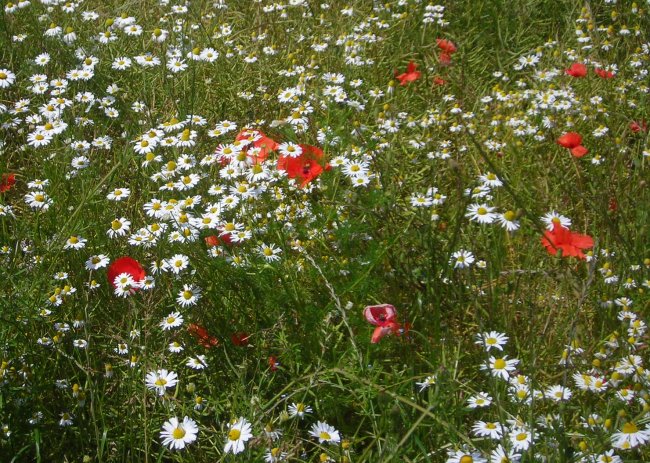
Back to the top and Index page
© Ryedale Natural History Society 2009; Photos © Gill Smith & Nan Sykes 2009